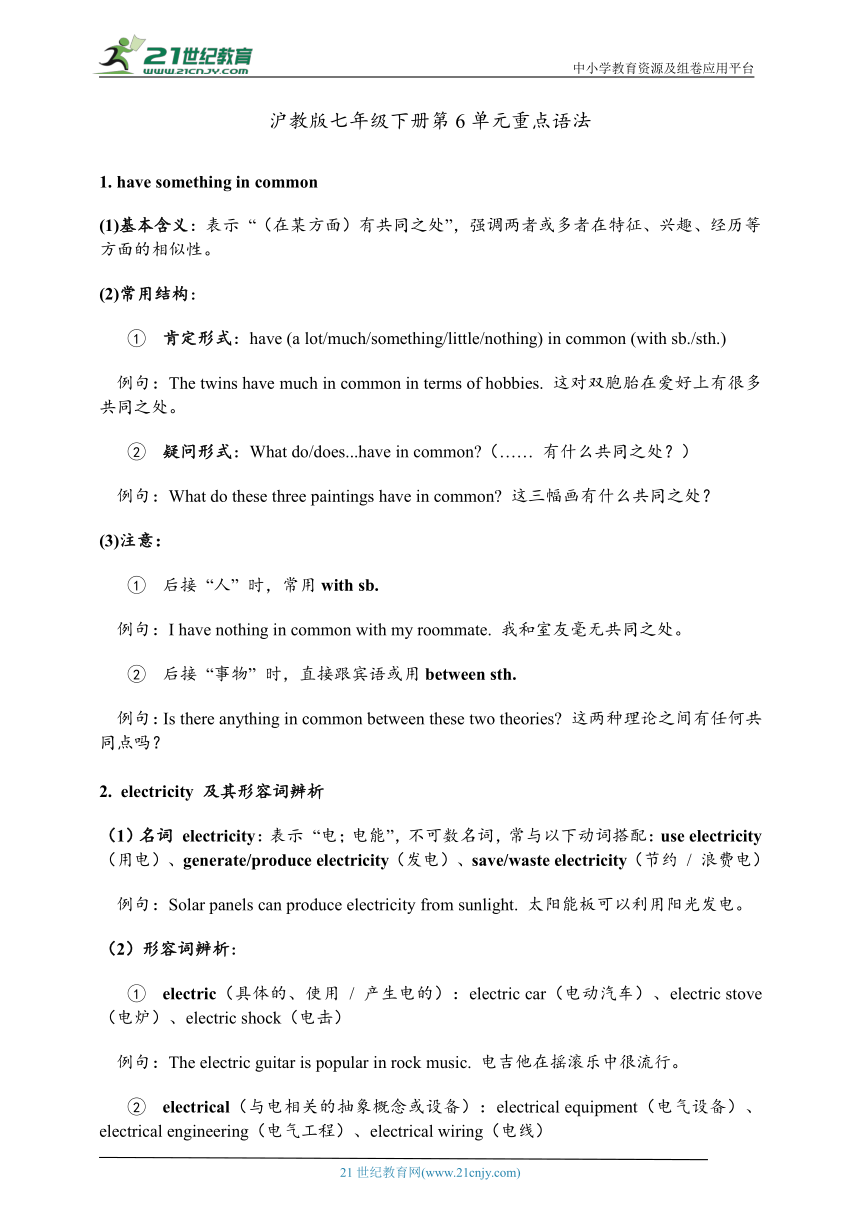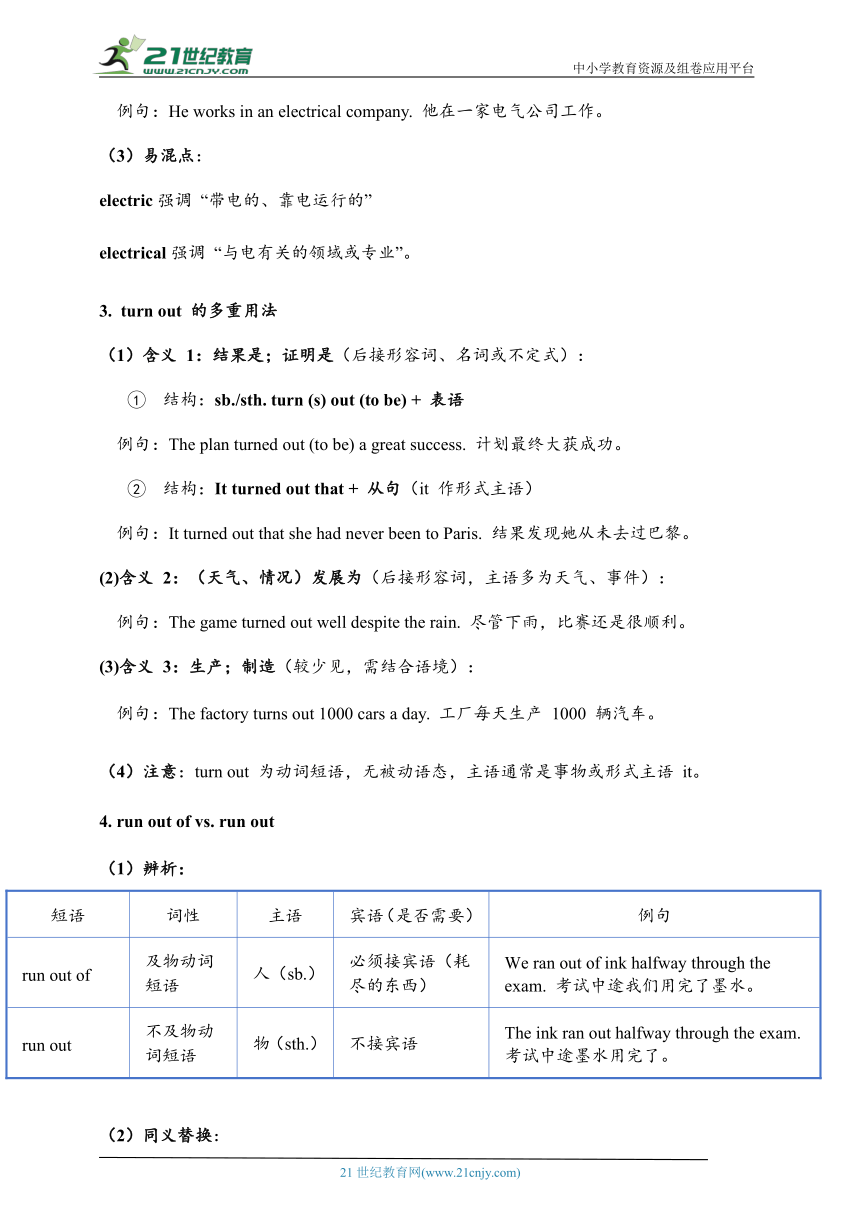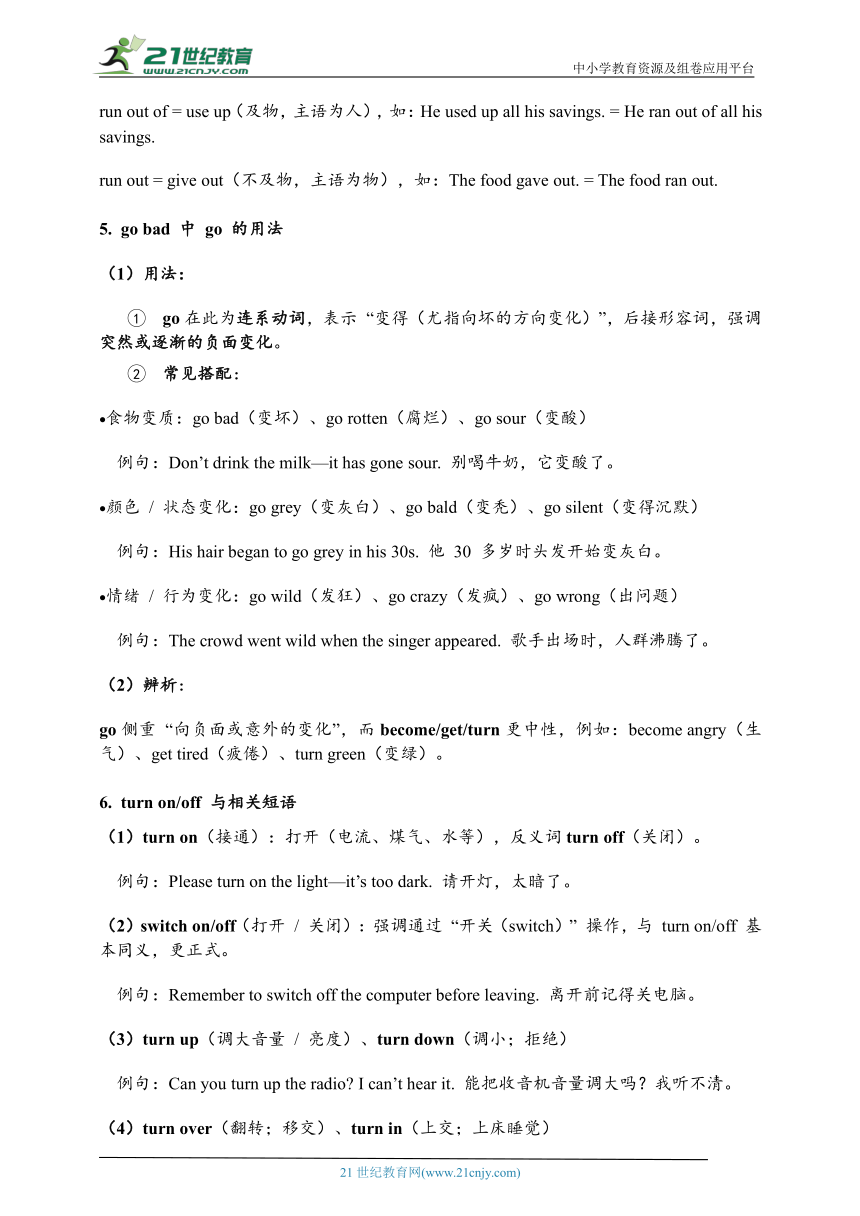沪教版七年级英语下册Unit 6 Electricity everywhere重点语法(学案)
文档属性
| 名称 | 沪教版七年级英语下册Unit 6 Electricity everywhere重点语法(学案) |  | |
| 格式 | doc | ||
| 文件大小 | 439.9KB | ||
| 资源类型 | 试卷 | ||
| 版本资源 | 沪教版 | ||
| 科目 | 英语 | ||
| 更新时间 | 2025-05-07 15:46:15 | ||
图片预览



文档简介
中小学教育资源及组卷应用平台
沪教版七年级下册第6单元重点语法
1. have something in common
(1)基本含义:表示 “(在某方面)有共同之处”,强调两者或多者在特征、兴趣、经历等方面的相似性。
(2)常用结构:
肯定形式:have (a lot/much/something/little/nothing) in common (with sb./sth.)
例句:The twins have much in common in terms of hobbies. 这对双胞胎在爱好上有很多共同之处。
疑问形式:What do/does...have in common (…… 有什么共同之处?)
例句:What do these three paintings have in common 这三幅画有什么共同之处?
(3)注意:
后接 “人” 时,常用 with sb.
例句:I have nothing in common with my roommate. 我和室友毫无共同之处。
后接 “事物” 时,直接跟宾语或用 between sth.
例句:Is there anything in common between these two theories 这两种理论之间有任何共同点吗?
electricity 及其形容词辨析
(1)名词 electricity:表示 “电;电能”,不可数名词,常与以下动词搭配:use electricity(用电)、generate/produce electricity(发电)、save/waste electricity(节约 / 浪费电)
例句:Solar panels can produce electricity from sunlight. 太阳能板可以利用阳光发电。
(2)形容词辨析:
electric(具体的、使用 / 产生电的):electric car(电动汽车)、electric stove(电炉)、electric shock(电击)
例句:The electric guitar is popular in rock music. 电吉他在摇滚乐中很流行。
electrical(与电相关的抽象概念或设备):electrical equipment(电气设备)、electrical engineering(电气工程)、electrical wiring(电线)
例句:He works in an electrical company. 他在一家电气公司工作。
(3)易混点:
electric 强调 “带电的、靠电运行的”
electrical 强调 “与电有关的领域或专业”。
turn out 的多重用法
(1)含义 1:结果是;证明是(后接形容词、名词或不定式):
结构:sb./sth. turn (s) out (to be) + 表语
例句:The plan turned out (to be) a great success. 计划最终大获成功。
结构:It turned out that + 从句(it 作形式主语)
例句:It turned out that she had never been to Paris. 结果发现她从未去过巴黎。
(2)含义 2:(天气、情况)发展为(后接形容词,主语多为天气、事件):
例句:The game turned out well despite the rain. 尽管下雨,比赛还是很顺利。
(3)含义 3:生产;制造(较少见,需结合语境):
例句:The factory turns out 1000 cars a day. 工厂每天生产 1000 辆汽车。
(4)注意:turn out 为动词短语,无被动语态,主语通常是事物或形式主语 it。
4. run out of vs. run out
(1)辨析:
短语 词性 主语 宾语(是否需要) 例句
run out of 及物动词短语 人(sb.) 必须接宾语(耗尽的东西) We ran out of ink halfway through the exam. 考试中途我们用完了墨水。
run out 不及物动词短语 物(sth.) 不接宾语 The ink ran out halfway through the exam. 考试中途墨水用完了。
(2)同义替换:
run out of = use up(及物,主语为人),如:He used up all his savings. = He ran out of all his savings.
run out = give out(不及物,主语为物),如:The food gave out. = The food ran out.
go bad 中 go 的用法
(1)用法:
go 在此为连系动词,表示 “变得(尤指向坏的方向变化)”,后接形容词,强调突然或逐渐的负面变化。
常见搭配:
食物变质:go bad(变坏)、go rotten(腐烂)、go sour(变酸)
例句:Don’t drink the milk—it has gone sour. 别喝牛奶,它变酸了。
颜色 / 状态变化:go grey(变灰白)、go bald(变秃)、go silent(变得沉默)
例句:His hair began to go grey in his 30s. 他 30 多岁时头发开始变灰白。
情绪 / 行为变化:go wild(发狂)、go crazy(发疯)、go wrong(出问题)
例句:The crowd went wild when the singer appeared. 歌手出场时,人群沸腾了。
(2)辨析:
go 侧重 “向负面或意外的变化”,而 become/get/turn 更中性,例如:become angry(生气)、get tired(疲倦)、turn green(变绿)。
turn on/off 与相关短语
(1)turn on(接通):打开(电流、煤气、水等),反义词 turn off(关闭)。
例句:Please turn on the light—it’s too dark. 请开灯,太暗了。
(2)switch on/off(打开 / 关闭):强调通过 “开关(switch)” 操作,与 turn on/off 基本同义,更正式。
例句:Remember to switch off the computer before leaving. 离开前记得关电脑。
(3)turn up(调大音量 / 亮度)、turn down(调小;拒绝)
例句:Can you turn up the radio I can’t hear it. 能把收音机音量调大吗?我听不清。
(4)turn over(翻转;移交)、turn in(上交;上床睡觉)
例句:He turned over the page and continued reading. 他翻了一页,继续阅读。
safety 的词性变化与搭配
(1)名词 safety(安全):
搭配:public safety(公共安全)、safety measures(安全措施)、safety belt(安全带)
例句:The government has taken many steps to improve road safety. 政府已采取许多措施改善道路安全。
(2)形容词 safe(安全的):
搭配:be safe to do sth.(做某事是安全的)、safe place(安全的地方)
例句:It’s safe to swim here—the water is shallow. 这里游泳很安全,水很浅。
(3)副词 safely(安全地):
搭配:drive/work safely(安全驾驶 / 工作)
例句:The plane landed safely despite the bad weather. 尽管天气恶劣,飞机仍安全着陆。
(4)易混词:safe(形容词)≠ safety(名词)
例句:We need to ensure the safety of passengers. 我们需确保乘客的安全。
connect 的常用结构
(1)动词 connect(连接):
connect A to/with B(把 A 与 B 连接):
例句:The teacher connected the story with a historical event. 老师将这个故事与一个历史事件联系起来。
be connected to/with(与…… 相连 / 相关):
例句1:The printer is connected to the computer via USB. 打印机通过 USB 与电脑连接。
例句2:Science is connected with everyday life. 科学与日常生活相关。
(2)名词 connection(连接;联系):
搭配:have a connection with(与…… 有关联)、establish a connection(建立联系)
例句:There’s a strong connection between diet and health. 饮食与健康密切相关。
(3)辨析:connect to 强调 “物理连接”(如电线、管道);connect with 可指 “抽象联系”(如情感、逻辑关联)。
9. care about vs. care for
(1)辨析:
短语 含义 例句
care about 关心;在乎(某事 / 某人) She cares about environmental protection. 她关心环境保护。
He doesn’t care about what others think. 他不在乎别人怎么想。
care for 1. 照顾(=look after)
2. 喜欢(=like) 1. She cared for her sick mother for years. 她照顾生病的母亲多年。
2. Would you care for a cup of tea 你想喝杯茶吗?
(2)注意:care about 后接事或人,强调 “在意”;care for 表 “喜欢” 时多用于疑问句或否定句。
例句:I don’t care for spicy food. 我不喜欢辣食。
10. amount 的用法与搭配
(1)用法:
the amount of + 不可数名词(…… 的数量,谓语动词用单数)
例句:The amount of time spent on screens is worrying. 花在屏幕上的时间令人担忧。
a large/great amount of + 不可数名词(大量的……,谓语动词用单数)
例句:A large amount of money was donated to the charity. 大量资金捐赠给了慈善机构。
large amounts of + 不可数名词(大量……,谓语动词用复数,因 amounts 为主语)
例句:Large amounts of waste water were poured into the river. 大量废水被排入河中。
(2)辨析:
amount → 不可数名词(如:time, money, water)
number → 可数名词(如:books, people, cars)
例如:a large number of books(大量书籍)
a large amount of water(大量水)
21世纪教育网 www.21cnjy.com 精品试卷·第 2 页 (共 2 页)
HYPERLINK "http://21世纪教育网(www.21cnjy.com)
" 21世纪教育网(www.21cnjy.com)
沪教版七年级下册第6单元重点语法
1. have something in common
(1)基本含义:表示 “(在某方面)有共同之处”,强调两者或多者在特征、兴趣、经历等方面的相似性。
(2)常用结构:
肯定形式:have (a lot/much/something/little/nothing) in common (with sb./sth.)
例句:The twins have much in common in terms of hobbies. 这对双胞胎在爱好上有很多共同之处。
疑问形式:What do/does...have in common (…… 有什么共同之处?)
例句:What do these three paintings have in common 这三幅画有什么共同之处?
(3)注意:
后接 “人” 时,常用 with sb.
例句:I have nothing in common with my roommate. 我和室友毫无共同之处。
后接 “事物” 时,直接跟宾语或用 between sth.
例句:Is there anything in common between these two theories 这两种理论之间有任何共同点吗?
electricity 及其形容词辨析
(1)名词 electricity:表示 “电;电能”,不可数名词,常与以下动词搭配:use electricity(用电)、generate/produce electricity(发电)、save/waste electricity(节约 / 浪费电)
例句:Solar panels can produce electricity from sunlight. 太阳能板可以利用阳光发电。
(2)形容词辨析:
electric(具体的、使用 / 产生电的):electric car(电动汽车)、electric stove(电炉)、electric shock(电击)
例句:The electric guitar is popular in rock music. 电吉他在摇滚乐中很流行。
electrical(与电相关的抽象概念或设备):electrical equipment(电气设备)、electrical engineering(电气工程)、electrical wiring(电线)
例句:He works in an electrical company. 他在一家电气公司工作。
(3)易混点:
electric 强调 “带电的、靠电运行的”
electrical 强调 “与电有关的领域或专业”。
turn out 的多重用法
(1)含义 1:结果是;证明是(后接形容词、名词或不定式):
结构:sb./sth. turn (s) out (to be) + 表语
例句:The plan turned out (to be) a great success. 计划最终大获成功。
结构:It turned out that + 从句(it 作形式主语)
例句:It turned out that she had never been to Paris. 结果发现她从未去过巴黎。
(2)含义 2:(天气、情况)发展为(后接形容词,主语多为天气、事件):
例句:The game turned out well despite the rain. 尽管下雨,比赛还是很顺利。
(3)含义 3:生产;制造(较少见,需结合语境):
例句:The factory turns out 1000 cars a day. 工厂每天生产 1000 辆汽车。
(4)注意:turn out 为动词短语,无被动语态,主语通常是事物或形式主语 it。
4. run out of vs. run out
(1)辨析:
短语 词性 主语 宾语(是否需要) 例句
run out of 及物动词短语 人(sb.) 必须接宾语(耗尽的东西) We ran out of ink halfway through the exam. 考试中途我们用完了墨水。
run out 不及物动词短语 物(sth.) 不接宾语 The ink ran out halfway through the exam. 考试中途墨水用完了。
(2)同义替换:
run out of = use up(及物,主语为人),如:He used up all his savings. = He ran out of all his savings.
run out = give out(不及物,主语为物),如:The food gave out. = The food ran out.
go bad 中 go 的用法
(1)用法:
go 在此为连系动词,表示 “变得(尤指向坏的方向变化)”,后接形容词,强调突然或逐渐的负面变化。
常见搭配:
食物变质:go bad(变坏)、go rotten(腐烂)、go sour(变酸)
例句:Don’t drink the milk—it has gone sour. 别喝牛奶,它变酸了。
颜色 / 状态变化:go grey(变灰白)、go bald(变秃)、go silent(变得沉默)
例句:His hair began to go grey in his 30s. 他 30 多岁时头发开始变灰白。
情绪 / 行为变化:go wild(发狂)、go crazy(发疯)、go wrong(出问题)
例句:The crowd went wild when the singer appeared. 歌手出场时,人群沸腾了。
(2)辨析:
go 侧重 “向负面或意外的变化”,而 become/get/turn 更中性,例如:become angry(生气)、get tired(疲倦)、turn green(变绿)。
turn on/off 与相关短语
(1)turn on(接通):打开(电流、煤气、水等),反义词 turn off(关闭)。
例句:Please turn on the light—it’s too dark. 请开灯,太暗了。
(2)switch on/off(打开 / 关闭):强调通过 “开关(switch)” 操作,与 turn on/off 基本同义,更正式。
例句:Remember to switch off the computer before leaving. 离开前记得关电脑。
(3)turn up(调大音量 / 亮度)、turn down(调小;拒绝)
例句:Can you turn up the radio I can’t hear it. 能把收音机音量调大吗?我听不清。
(4)turn over(翻转;移交)、turn in(上交;上床睡觉)
例句:He turned over the page and continued reading. 他翻了一页,继续阅读。
safety 的词性变化与搭配
(1)名词 safety(安全):
搭配:public safety(公共安全)、safety measures(安全措施)、safety belt(安全带)
例句:The government has taken many steps to improve road safety. 政府已采取许多措施改善道路安全。
(2)形容词 safe(安全的):
搭配:be safe to do sth.(做某事是安全的)、safe place(安全的地方)
例句:It’s safe to swim here—the water is shallow. 这里游泳很安全,水很浅。
(3)副词 safely(安全地):
搭配:drive/work safely(安全驾驶 / 工作)
例句:The plane landed safely despite the bad weather. 尽管天气恶劣,飞机仍安全着陆。
(4)易混词:safe(形容词)≠ safety(名词)
例句:We need to ensure the safety of passengers. 我们需确保乘客的安全。
connect 的常用结构
(1)动词 connect(连接):
connect A to/with B(把 A 与 B 连接):
例句:The teacher connected the story with a historical event. 老师将这个故事与一个历史事件联系起来。
be connected to/with(与…… 相连 / 相关):
例句1:The printer is connected to the computer via USB. 打印机通过 USB 与电脑连接。
例句2:Science is connected with everyday life. 科学与日常生活相关。
(2)名词 connection(连接;联系):
搭配:have a connection with(与…… 有关联)、establish a connection(建立联系)
例句:There’s a strong connection between diet and health. 饮食与健康密切相关。
(3)辨析:connect to 强调 “物理连接”(如电线、管道);connect with 可指 “抽象联系”(如情感、逻辑关联)。
9. care about vs. care for
(1)辨析:
短语 含义 例句
care about 关心;在乎(某事 / 某人) She cares about environmental protection. 她关心环境保护。
He doesn’t care about what others think. 他不在乎别人怎么想。
care for 1. 照顾(=look after)
2. 喜欢(=like) 1. She cared for her sick mother for years. 她照顾生病的母亲多年。
2. Would you care for a cup of tea 你想喝杯茶吗?
(2)注意:care about 后接事或人,强调 “在意”;care for 表 “喜欢” 时多用于疑问句或否定句。
例句:I don’t care for spicy food. 我不喜欢辣食。
10. amount 的用法与搭配
(1)用法:
the amount of + 不可数名词(…… 的数量,谓语动词用单数)
例句:The amount of time spent on screens is worrying. 花在屏幕上的时间令人担忧。
a large/great amount of + 不可数名词(大量的……,谓语动词用单数)
例句:A large amount of money was donated to the charity. 大量资金捐赠给了慈善机构。
large amounts of + 不可数名词(大量……,谓语动词用复数,因 amounts 为主语)
例句:Large amounts of waste water were poured into the river. 大量废水被排入河中。
(2)辨析:
amount → 不可数名词(如:time, money, water)
number → 可数名词(如:books, people, cars)
例如:a large number of books(大量书籍)
a large amount of water(大量水)
21世纪教育网 www.21cnjy.com 精品试卷·第 2 页 (共 2 页)
HYPERLINK "http://21世纪教育网(www.21cnjy.com)
" 21世纪教育网(www.21cnjy.com)
同课章节目录
